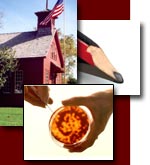| Site Map | Contacts | Links | Newsletter | |
Homeschool:
Science
The word "science" literally means "knowing." The American Heritage Dictionary states, "The observation, identification, description, experimental investigation, and theoretical explanation of natural phenomena."
Scientific Method
-
State the problem or question you want to investigate.
-
Research what is already known about the question or problem.
-
Form a hypothesis or an educated guess to what the answer might be to the question.
-
Design and carried out experiments to test your hypothesis true or false. Make observations. Take measurements. Write them down.
-
Form your conclusions. Interpret the results of the experiment. If no answer was found, try a new approach and repeat these steps over again.
To ensure accurate results many times two test are conducted: The control group or test and the experimental group or test.
Matter and Energy
The universe is made up of matter and energy. Matter can be changed into energy. Einstein's famous formula show this relationship of matter and energy, E=MC2.
- Properties of Matter
- General
- Matter has mass or weight.
- Matter has volume, or takes up space, length, height, and width.
- Matter has density, how close the atoms are packed together. Density equals mass divided by volume.
- Special
- Physical properties and changes
- Solid form. Melting (solid to liquid) and Freezing (liquid to solid). Crystalline solids-regular repeating pattern. Amorphous solids-solids that do not keep their shapes like rubber or wax. Some scientists say they are very slow moving liquids.
- Liquid form. Each kind of matter has its own melting and freezing point.
- Gas form. Evaporation (liquid to gas change) and condensation
(gas to liquid).
- Gas laws: Boyle's Law-the volume of gas varies inversely with its pressure provided the temperature does not change. Charles' Law - the volume of gas varies directly with the temperature.
- Sublimation-A change from solid to gas without turning into a liquid first like dry ice.
- Chemical properties and changes-How different kinds of matter interact with each other. See chemistry page.
- Physical properties and changes
- General
- Classification of Matter
- Elements- simple substances with one kind of atom, same number of protons in the nucleus.
- Compounds- combinations of elements and molecules, more than one kind of atom.
- Mixtures and solutions. Mixtures are two or more substances combined
which keep most of their own properties. Solution is when one substance
dissolves into another one.
Naturally occurring substances are called minerals. They may be pure elements or compounds.
- Composition of Matter
- The structure of the Atom and its subatomic particles. Neutron, proton, and electron. Protons and Neutrons are made up of two kinds of quarks called up and down. See Physics.
- Bonding of Atoms-Covalent bonding, and ionic bonding.
- Organization of Atoms. The Periodic Table, special groups, metals, non-metals.
- Chemistry of Matter
- Chemical reactions, acids and bases see chemistry page.
- Carbon bonding (life) see Biology page.
Energy
Four Forces in the Universe according to strength.
-
Strong force- transmitted by gluons which bind protons and neutrons together in the nucleus of an atom also called the nuclear force. Releasing its power will cause a nuclear explosion.
-
Electromagnetic force- transmitted by photons which bind electrons in atoms which includes all chemical reactions. Photons are units of electromagnetic radiation including radio waves, light, and X-rays.
-
Weak force- transmitted by weak bosons of w+, w-, and z particles which involves radioactive decay.
-
Gravity- transmitted by gravitons.
